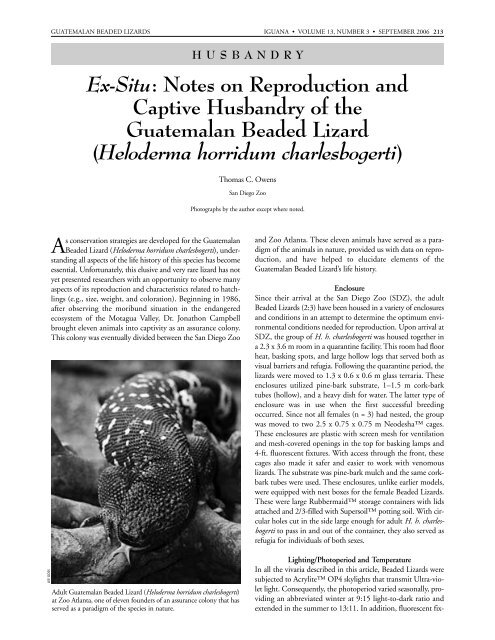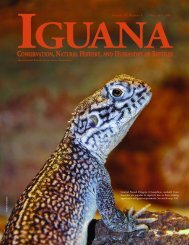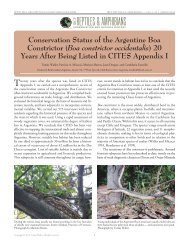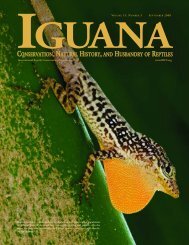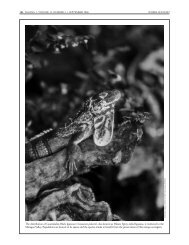Iguana13_3 Ex-Situ Notes on Reproduction Beaded Lizard.pdf
Iguana13_3 Ex-Situ Notes on Reproduction Beaded Lizard.pdf
Iguana13_3 Ex-Situ Notes on Reproduction Beaded Lizard.pdf
Create successful ePaper yourself
Turn your PDF publications into a flip-book with our unique Google optimized e-Paper software.
LEE GOSS<br />
GUATEMALAN BEADED LIZARDS<br />
As c<strong>on</strong>servati<strong>on</strong> strategies are developed for the Guatemalan<br />
<strong>Beaded</strong> <strong>Lizard</strong> (Heloderma horridum charlesbogerti), understanding<br />
all aspects of the life history of this species has become<br />
essential. Unfortunately, this elusive and very rare lizard has not<br />
yet presented researchers with an opportunity to observe many<br />
aspects of its reproducti<strong>on</strong> and characteristics related to hatchlings<br />
(e.g., size, weight, and colorati<strong>on</strong>). Beginning in 1986,<br />
after observing the moribund situati<strong>on</strong> in the endangered<br />
ecosystem of the Motagua Valley, Dr. J<strong>on</strong>ath<strong>on</strong> Campbell<br />
brought eleven animals into captivity as an assurance col<strong>on</strong>y.<br />
This col<strong>on</strong>y was eventually divided between the San Diego Zoo<br />
HUSBANDRY<br />
IGUANA • VOLUME 13, NUMBER 3 • SEPTEMBER 2006 213<br />
<str<strong>on</strong>g>Ex</str<strong>on</strong>g>-<str<strong>on</strong>g>Situ</str<strong>on</strong>g>: <str<strong>on</strong>g>Notes</str<strong>on</strong>g> <strong>on</strong> Reproducti<strong>on</strong> and<br />
Captive Husbandry of the<br />
Guatemalan <strong>Beaded</strong> <strong>Lizard</strong><br />
(Heloderma horridum charlesbogerti)<br />
Adult Guatemalan <strong>Beaded</strong> <strong>Lizard</strong> (Heloderma horridum charlesbogerti)<br />
at Zoo Atlanta, <strong>on</strong>e of eleven founders of an assurance col<strong>on</strong>y that has<br />
served as a paradigm of the species in nature.<br />
Thomas C. Owens<br />
San Diego Zoo<br />
Photographs by the author except where noted.<br />
and Zoo Atlanta. These eleven animals have served as a paradigm<br />
of the animals in nature, provided us with data <strong>on</strong> reproducti<strong>on</strong>,<br />
and have helped to elucidate elements of the<br />
Guatemalan <strong>Beaded</strong> <strong>Lizard</strong>’s life history.<br />
Enclosure<br />
Since their arrival at the San Diego Zoo (SDZ), the adult<br />
<strong>Beaded</strong> <strong>Lizard</strong>s (2:3) have been housed in a variety of enclosures<br />
and c<strong>on</strong>diti<strong>on</strong>s in an attempt to determine the optimum envir<strong>on</strong>mental<br />
c<strong>on</strong>diti<strong>on</strong>s needed for reproducti<strong>on</strong>. Up<strong>on</strong> arrival at<br />
SDZ, the group of H. h. charlesbogerti was housed together in<br />
a 2.3 x 3.6 m room in a quarantine facility. This room had floor<br />
heat, basking spots, and large hollow logs that served both as<br />
visual barriers and refugia. Following the quarantine period, the<br />
lizards were moved to 1.3 x 0.6 x 0.6 m glass terraria. These<br />
enclosures utilized pine-bark substrate, 1–1.5 m cork-bark<br />
tubes (hollow), and a heavy dish for water. The latter type of<br />
enclosure was in use when the first successful breeding<br />
occurred. Since not all females (n = 3) had nested, the group<br />
was moved to two 2.5 x 0.75 x 0.75 m Neodesha cages.<br />
These enclosures are plastic with screen mesh for ventilati<strong>on</strong><br />
and mesh-covered openings in the top for basking lamps and<br />
4-ft. fluorescent fixtures. With access through the fr<strong>on</strong>t, these<br />
cages also made it safer and easier to work with venomous<br />
lizards. The substrate was pine-bark mulch and the same corkbark<br />
tubes were used. These enclosures, unlike earlier models,<br />
were equipped with nest boxes for the female <strong>Beaded</strong> <strong>Lizard</strong>s.<br />
These were large Rubbermaid storage c<strong>on</strong>tainers with lids<br />
attached and 2/3-filled with Supersoil potting soil. With circular<br />
holes cut in the side large enough for adult H. h. charlesbogerti<br />
to pass in and out of the c<strong>on</strong>tainer, they also served as<br />
refugia for individuals of both sexes.<br />
Lighting/Photoperiod and Temperature<br />
In all the vivaria described in this article, <strong>Beaded</strong> <strong>Lizard</strong>s were<br />
subjected to Acrylite OP4 skylights that transmit Ultra-violet<br />
light. C<strong>on</strong>sequently, the photoperiod varied seas<strong>on</strong>ally, providing<br />
an abbreviated winter at 9:15 light-to-dark ratio and<br />
extended in the summer to 13:11. In additi<strong>on</strong>, fluorescent fix-


